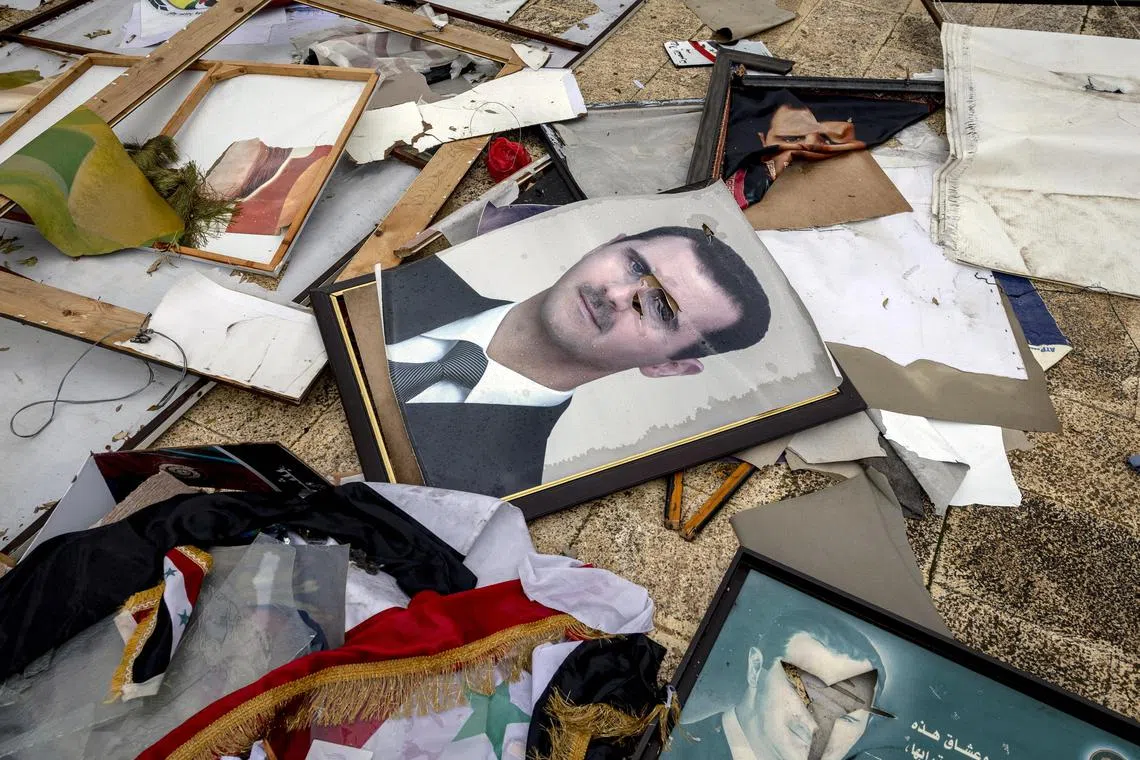Syrian rebels took a year to plan Bashar al-Assad’s ouster, says report
Sign up now: Get ST's newsletters delivered to your inbox

Defaced portraits of ousted Syrian President Bashar al-Assad outside a municipal building in Aleppo, Syria, on Dec 12.
PHOTO: NYTIMES
Follow topic:
LONDON - Syria’s Islamist-led rebel alliance had been planning the surprise ouster of President Bashar al-Assad for a year, an opposition military leader told The Guardian in an interview published on Dec 13.
The Hayat Tahrir al-Sham (HTS) Islamist group, which says it has moved away from its roots in Al-Qaeda, has long controlled a part of north-west Syria.
After being weakened in a 2019 government operation, the group realised the “fundamental problem was the absence of unified leadership and control over battle”, Mr Abu Hassan al-Hamwi, an HTS commander and former leader of the group’s military wing, told the British daily.
Correcting those mistakes, HTS began in 2023 preparing for a retaliatory operation dubbed “Deterring Aggression” to oust Mr Assad.
It strengthened its control over opposition groups in the north-west and trained up its own militia, developing a “comprehensive military doctrine”.
HTS then tried to bring together rebel and militant forces in southern Syria, under Mr Assad’s control for the past six years, to create a “unified war room”, according to The Guardian article.
The “war room” convened commanders of 25 opposition groups who could steer the offensive against Mr Assad from the south, with HTS driving in from the north, and converging in the capital and Mr Assad’s stronghold Damascus.
The moment to launch the operation came in late November, with Syria’s staunch allies Iran and Russia distracted by other conflicts.
Over the weekend, the rebels succeeded in entering Damascus
“We had a conviction, supported by historical precedent – that ‘Damascus cannot fall until Aleppo falls’,” Mr Hamwi said.
“The strength of the Syrian revolution was concentrated in the north, and we believed that once Aleppo was liberated, we could move southwards, towards Damascus,” he added.
The plan also involved developing better weapons to counter the technology Tehran and Moscow provided to the government forces.
“We needed reconnaissance drones, attack drones and suicide drones, with a focus on range and endurance,” Mr Hamwi said, with drone production beginning as early as 2019.
Mr Hamwi named a new exploding or “suicide drone” the Shahin drone, meaning “falcon” in Arabic, which “symbolised its precision and power”, the military leader said.
The Shahin drone was deployed for the first time against Mr Assad’s forces earlier in December, according to The Guardian, disabling artillery vehicles.
HTS is proscribed as a terrorist organisation by several Western powers, but it has sought to reassure religious minorities and other governments since coming to power that it will usher in an inclusive leadership.
“We affirm that minorities in Syria are part of the nation and have the right to practise their rituals, education and services like every other Syrian citizen,” Mr Hamwi said.
“The regime planted division, and we are trying, as much as possible, to bridge these divides,” he added. AFP

